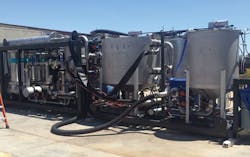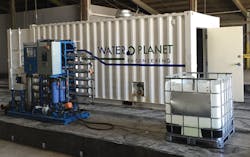By Alexander Severt
The ability of a computer-powered machine to take a set of information, analyze, decide, and autonomously take actions is the definition of artificial intelligence (AI). Examples of AI are commonly linked to a helpful humanoid robot, which is more entertainment from a science fiction perspective than a realistic integration into society. Intelligent machines can be built to extend past the five human senses and the physical limitations of the person-like figure that we are familiar with.
In a world where computer-controlled cars can autonomously drive a person from point A to point B, the water industry, which has huge impacts on our day-to-day lives, needs to be brought into the technology era. For instance, most existing water industry infrastructure still requires human operators and engineers to understand and anticipate, as best as humanly possible, how to respond to continuous changes in influent water quality (diurnal, seasonal, episodic) in the hopes that more sustainable operations can be achieved.
Massive amounts of real-time data from existing water quality and process monitoring technologies can be acquired, and would inform conventional, human-driven, trial-and-error process adaptation and optimization approaches. However, even well-trained operators and engineers with access to “big data” require time to process, analyze, normalize, trend out and predict (largely from experience and intuition) what operational changes need to be made at any given time.
Such delays in response time can lead to damaged hardware, decreased throughput, or worse, compromised water quality. From a business perspective, these delays erode water plant profits and force businesses to try to cut corners in other, less responsible ways.
AI is the future of the water industry. It can play a pivotal role in making our society’s current water infrastructure more robust, more profitable, and ultimately, safer.
Benefits of AI
Artificial intelligence will bring features to water treatment that society has grown accustomed to in other areas of their lives. An operator will get an SMS message informing them that a chemical tank needs to be refilled, and procurement personnel will receive projections of when inventories need replenishment. An automatic daily report will be emailed to managers and administrators outlining the previous day’s performance and operating costs, and predictive analytics. Executives in an off-site business meeting will be able to access live data (via the cloud) communicating net water production, energy consumption and profits for all of their operating plants. As technology continues to advance, emails, text messages, and web pages will be surpassed by more creative ways of interfacing with these large systems.
Modern water filtration systems will accommodate feed water quality excursions and adapt/adjust immediately to assure optimal operating conditions are met. Forecasting algorithms will soon integrate system data to predict the useful lifetime of membranes based on ‘health indicators’ and predict energy consumption based on meteorological data.
The complex mathematics that goes into anticipating different features of water infrastructure can’t possibly be calculated by humans in a time frame that is helpful. Computers excel at these functions, including compiling waves of information - performing integrations, derivatives, parametric model fittings and multivariate statistics - ultimately learning with perfect memory and no time off.
It’s through the use of advanced computing and control philosophies that operators, engineers, and their companies will be able to make more informed decisions in a timely manner. For example, if a system is hitting a maximum constraint seasonally, such as exceeding the maximum amount of backwashing needed to maintain sustainable operation, managers can identify and attempt to mitigate this cyclical behavior. That might entail adding another process upstream to ease the disruption or upgrading the existing system to not exceed any constraints during specific periods. Without artificial intelligence, the aforementioned cyclical behavior could ruin hardware before operators have a chance to identify the issue.
Misconceptions about AI
With any new technology or change in the status quo, there is a period of adaptation and adjustment before the benefits are fully appreciated and understood. Integration of AI into water treatment systems and processes presents similar challenges.
For example, one common misconception is that with AI, operators within the water industry will lose complete control of their systems, and thus if something goes wrong, there would be no way to correct it. In fact, the ability to manually control and override these expensive systems is not lost with the addition of AI. Quite simply, AI will bring the accurate, autonomous, and immediate response features of a computer to the hands of skilled operators.
Another concern is the impact on plant operators. The truth is that AI will not displace them from the workforce. Instead, AI will offer them faster decision-making capabilities and flexibility to allocate busy resources to solve other operational challenges. Large, complex water systems in conjunction with AI will encourage operators to take a macroscopic view of the system and determine how better to manage the processes. Yet still, when something in the system needs repair, a highly-skilled operator would be deployed to verify and solve the problem.
In the same way that factory robots are redefining the automotive industry while increasing general employment (according to the U.S. Bureau of Labor Statistics), the water industry will continue to grow employment opportunities through and beyond adoption of intelligence.
Status in the Water Treatment Industry
Some companies are already pursuing some of these AI advantages. JEA Management introduced a new system, Optimized System Controls of Aquifer Resources, or OSCAR, which is experimenting with automated supervisory control. Published in a June 2006 edition of WaterWorld, OSCAR regulated the pumping of water from the aquifer by evaluating data from a variety of sources. JEA uses a combination of weather-related and system data to optimize the water supply all year round. Pairing these automated controls with an extended knowledge base will lead to a network of systems that can automatically communicate with each other and acclimate when one system requires more resources than another in order to keep operating costs as low as possible.
Water Planet’s IntelliFlux™ water filtration control technology is the first use of true AI in the water treatment industry. The company already incorporates AI into a unique hardware/software arrangement to deliver better performance than conventionally controlled water treatment systems. IntelliFlux controls already offer the ability to rapidly respond to a variety of operational challenges without operator assistance. Implemented via a SCADA platform, IntelliFlux alerts operators via a text or email whenever the system is not operating optimally, and provides explicit instructions about how to optimize operations. Anyone with permission can log in securely and remotely to monitor and change critical operating and control parameters on the system.
Conclusion
Creativity is not a strength of artificial intelligence; computers are only as smart as we make them. Therefore, human ingenuity will always have a place in both industrial and municipal settings.
Programmable logic controllers and system automation have already relieved operators from being bogged down with the repetitive, mind-numbing tasks of basic operations. It is now time to pull these same systems into the next generation of intelligent systems, where they can operate with optimal engagement of humans.
Computers are everywhere: we can talk to people on the other side of the world; we can set our thermostat or lock our car from a phone; and we can order a pizza from a watch. Why does an operator need to stand in front of a screen watching and monitoring a water filtration system, just waiting for something to go wrong? The answer is: they don’t.
About the Author: Alexander Severt is a mechanical and design engineer with Water Planet Inc. (www.waterplanet.com), an award-winning global supplier of high-performance membrane-based water treatment solutions. He can be reached at [email protected].




